The Automotive Roof Bar & Roof Racks Market is estimated to be valued at USD 1.6 billion in 2025 and is projected to reach USD 3.3 billion by 2035, registering a compound annual growth rate (CAGR) of 7.5% over the forecast period.
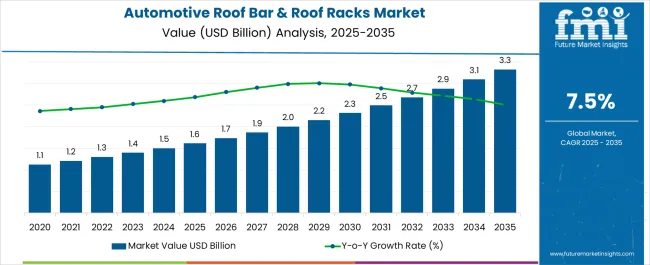
| Metric | Value |
|---|---|
| Automotive Roof Bar & Roof Racks Market Estimated Value in (2025 E) | USD 1.6 billion |
| Automotive Roof Bar & Roof Racks Market Forecast Value in (2035 F) | USD 3.3 billion |
| Forecast CAGR (2025 to 2035) | 7.5% |
The Automotive Roof Bar and Roof Racks market is experiencing robust growth, driven by increasing consumer demand for enhanced vehicle utility and cargo-carrying capabilities across passenger and commercial vehicles. The trend of lifestyle mobility, including outdoor activities, adventure travel, and sports equipment transport, is significantly contributing to market adoption. Advances in design, aerodynamics, and load-bearing technology are improving performance while minimizing fuel consumption and wind resistance.
Rising consumer preference for modular and customizable accessories, combined with the availability of lightweight and durable materials, is further accelerating demand. Integration of roof bars and racks with modern vehicle designs is enhancing aesthetic appeal and functionality, supporting adoption among automotive manufacturers and end users.
Regulatory compliance related to safety, load limits, and material standards is driving manufacturers to optimize product design and performance As automotive production expands globally and aftermarket upgrades gain popularity, the market is expected to witness continued growth, with innovation in materials and product designs being key factors influencing segmental expansion.
The automotive roof bar & roof racks market is segmented by vehicle type, product type, material, sales channel, and geographic regions. By vehicle type, automotive roof bar & roof racks market is divided into Passenger Car, Light Commercial Vehicle, and Heavy Commercial Vehicle. In terms of product type, automotive roof bar & roof racks market is classified into Railing, Clamping, Fix Point, Bare Roof Mount, Raised Rail, Rain Gutter, and Others. Based on material, automotive roof bar & roof racks market is segmented into Aluminum Alloy, Steel Alloy, Composite Plastic, and Others. By sales channel, automotive roof bar & roof racks market is segmented into OEMs and Aftermarket. Regionally, the automotive roof bar & roof racks industry is classified into North America, Latin America, Western Europe, Eastern Europe, Balkan & Baltic Countries, Russia & Belarus, Central Asia, East Asia, South Asia & Pacific, and the Middle East & Africa.
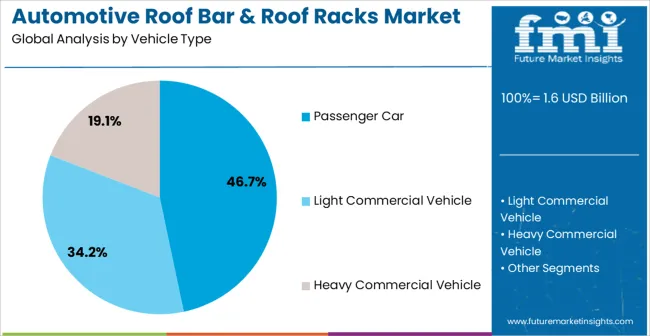
The passenger car segment is projected to hold 46.7% of the market revenue in 2025, making it the leading vehicle type. Growth in this segment is being driven by increasing consumer preference for vehicles that offer flexible storage and transportation solutions for daily use and recreational activities. Automotive roof bars and racks for passenger cars provide convenient options for transporting luggage, sports equipment, bicycles, and outdoor gear without compromising cabin space.
The adoption of lightweight and durable materials enhances fuel efficiency and overall vehicle performance, which is particularly important for consumer satisfaction. Passenger car manufacturers are increasingly offering factory-installed or OEM-compatible roof bars and racks as standard or optional features, which improves integration and aesthetic appeal. Rising disposable incomes, urbanization, and growth in the adventure tourism sector are further supporting adoption.
The segment benefits from strong aftermarket opportunities, as consumers increasingly upgrade vehicles to meet evolving lifestyle needs Technological innovation and product customization are expected to sustain the leadership of passenger cars within this market.
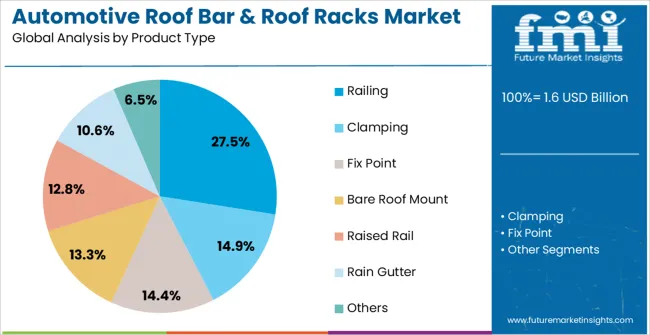
The railing product type segment is anticipated to account for 27.5% of the market revenue in 2025, establishing it as the leading product type. Railing systems are preferred due to their versatility, ease of installation, and ability to support multiple roof accessories. They provide a stable base for mounting crossbars, cargo boxes, bike carriers, and other equipment, which enhances the functional utility of vehicles.
Manufacturers are focusing on lightweight and corrosion-resistant designs to improve durability and performance across diverse environmental conditions. The modular nature of railing systems allows consumers to customize their setup according to cargo needs and usage patterns.
Growing consumer awareness of safety standards, combined with regulatory requirements for load-bearing and secure attachment, is further supporting the adoption of railing-type roof racks As urban mobility trends and recreational travel continue to rise, the railing product type segment is expected to maintain market leadership, driven by performance, adaptability, and convenience for both OEM and aftermarket applications.
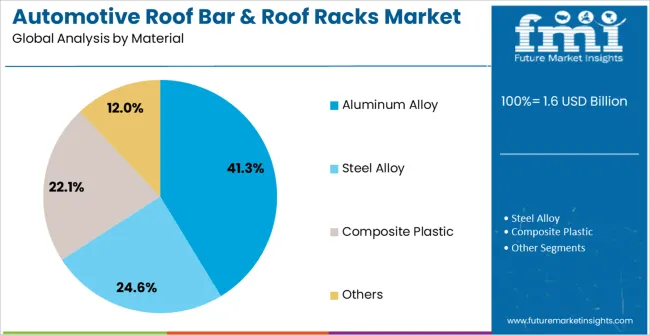
The aluminum alloy material segment is projected to hold 41.3% of the market revenue in 2025, making it the leading material category. Its growth is being driven by the combination of lightweight properties, corrosion resistance, and high structural strength, which enhances vehicle performance and longevity. Aluminum alloys reduce overall vehicle weight, contributing to improved fuel efficiency and lower emissions, aligning with regulatory mandates and consumer preferences for sustainability.
Advanced manufacturing techniques enable precise fabrication and design flexibility, allowing for aerodynamic and aesthetically appealing roof bars and racks. The material’s durability under diverse environmental conditions, including extreme temperatures and moisture, supports long-term performance and reliability.
Increasing consumer awareness of material quality, alongside OEM and aftermarket adoption trends, reinforces its market position As automotive manufacturers prioritize lightweight and high-performance accessories to meet functional and regulatory requirements, aluminum alloy is expected to remain the preferred choice, sustaining its leadership in the automotive roof bar and roof rack market.
Automotive roof bars is employed for effective transportation of load while travelling. By placing the luggage on roof bar, the cargo space area inside the vehicle can be utilized more effectively. There are mainly three parts of the automotive roof bar are towers, rail and mounts. The rail is used for supporting the frame of roof bar.
On the other hand, the roof racks are an assembly of bars that are attached at the roof of the vehicles for carry bulk items for instance, bicycles, luggage and various carriers without consuming the interior space of the vehicle. Earlier, the roof bar & roof racks were mounted directly on the roof of the vehicles.
But now, these bars and racks can be attached with the help of hooks or joint on the roof of the vehicle as well can be removed after use. Flexibility, low maintenance cost, low operational cost and low maintenance cost remain the prime focus of key manufacturer in the global automotive roof bar & roof racks market during the forecast period.
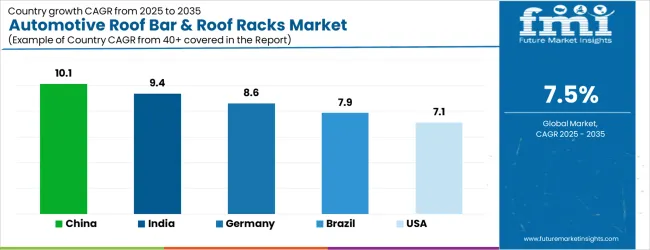
| Country | CAGR |
|---|---|
| China | 10.1% |
| India | 9.4% |
| Germany | 8.6% |
| Brazil | 7.9% |
| USA | 7.1% |
| UK | 6.4% |
| Japan | 5.6% |
The Automotive Roof Bar & Roof Racks Market is expected to register a CAGR of 7.5% during the forecast period, exhibiting varied country level momentum. China leads with the highest CAGR of 10.1%, followed by India at 9.4%. Developed markets such as Germany, France, and the UK continue to expand steadily, while the USA is likely to grow at consistent rates. Japan posts the lowest CAGR at 5.6%, yet still underscores a broadly positive trajectory for the global Automotive Roof Bar & Roof Racks Market. In 2024, Germany held a dominant revenue in the Western Europe market and is expected to grow with a CAGR of 8.6%. The USA Automotive Roof Bar & Roof Racks Market is estimated to be valued at USD 588.4 million in 2025 and is anticipated to reach a valuation of USD 588.4 million by 2035. Sales are projected to rise at a CAGR of 0.0% over the forecast period between 2025 and 2035. While Japan and South Korea markets are estimated to be valued at USD 75.0 million and USD 50.7 million respectively in 2025.
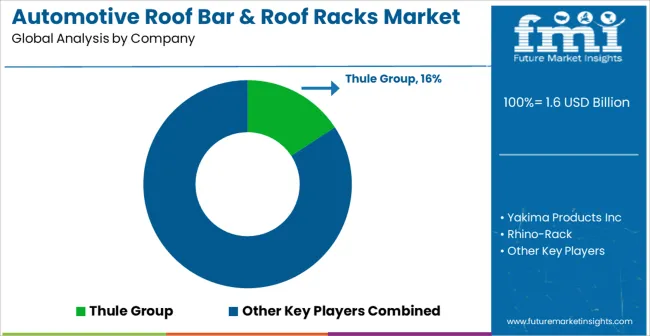
| Item | Value |
|---|---|
| Quantitative Units | USD 1.6 Billion |
| Vehicle Type | Passenger Car, Light Commercial Vehicle, and Heavy Commercial Vehicle |
| Product Type | Railing, Clamping, Fix Point, Bare Roof Mount, Raised Rail, Rain Gutter, and Others |
| Material | Aluminum Alloy, Steel Alloy, Composite Plastic, and Others |
| Sales Channel | OEMs and Aftermarket |
| Regions Covered | North America, Europe, Asia-Pacific, Latin America, Middle East & Africa |
| Country Covered | United States, Canada, Germany, France, United Kingdom, China, Japan, India, Brazil, South Africa |
| Key Companies Profiled | Thule Group, Yakima Products Inc, Rhino-Rack, CRUZBER SA, Atera GmbH, JAC Products, MINTH Group, BOSAL, NEUMANN, spol. s r.o., Rola, Perrycraft, and VDL Hapro |
The global automotive roof bar & roof racks market is estimated to be valued at USD 1.6 billion in 2025.
The market size for the automotive roof bar & roof racks market is projected to reach USD 3.3 billion by 2035.
The automotive roof bar & roof racks market is expected to grow at a 7.5% CAGR between 2025 and 2035.
The key product types in automotive roof bar & roof racks market are passenger car, light commercial vehicle and heavy commercial vehicle.
In terms of product type, railing segment to command 27.5% share in the automotive roof bar & roof racks market in 2025.
Explore Similar Insights

Thank you!
You will receive an email from our Business Development Manager. Please be sure to check your SPAM/JUNK folder too.
Chat With
MaRIA